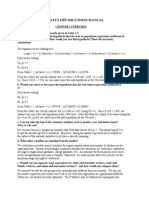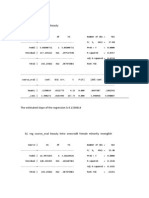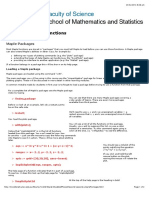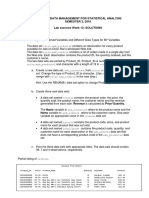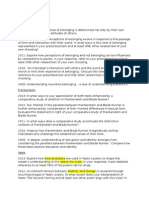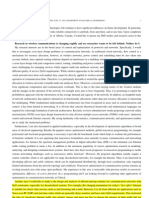Tutorials2016s1 Week9 Answers
Uploaded by
yizzyTutorials2016s1 Week9 Answers
Uploaded by
yizzyECON2206IntroductoryEconometrics
Week9TutorialExercises
Readings
Read Chapter 8 thoroughly.
Make sure that you know the meanings of the Key Terms at the chapter end.
Review Questions (these may or may not be discussed in tutorial classes)
What is heteroskedasticity in a regression model?
In the presence of heteroskedasticity, are the tstat and Fstat from the usual OLS still valid?
Why? Are there any other problems with OLS under heteroscedasticity?
What are the heteroskedasticityrobust standard errors? How do you use them in Stata?
How do you detect if there is heteroskedasticity?
If heteroskedasticity is present in a known form, how would you estimate the model?
If heteroskedasticity is present in an unknown form, how would you estimate the model?
What are the steps in the FGLS estimation?
How would you handle the heteroskedasticity of the LPM?
Problem Set (these will be discussed in tutorial classes)
Q1. Wooldridge 8.1
Parts (ii) and (iii). The homoskedasticity assumption played no role in Chapter 5 in showing
that OLS is consistent. But we know that heteroskedasticity causes statistical inference based on
the usual t and F statistics to be invalid, even in large samples. As heteroskedasticity is a
violation of the GaussMarkov assumptions, OLS is no longer BLUE.
Q2. Wooldridge 8.2
With Var(u|inc,price,educ,female) = 2inc2, h(x) = inc2, where h(x) is the heteroskedasticity
function defined in equation (8.21). Therefore, h(x) = inc, and so the transformed equation is
obtained by dividing the original equation by inc:
Notice that ,which is the slope on inc in the original model, is now a constant in the
transformed equation. This is simply a consequence of the form of the heteroskedasticity and
the functional forms of the explanatory variables in the original equation. For many functional
forms there will be no constant in the transformed model.
Q3. Wooldridge 8.5
(i) No. For each coefficient, the usual standard errors and the heteroskedasticityrobust ones
are practically very similar.
(ii) The effect is .029(4) = .116, so the probability of smoking falls by about .116.
(iii) As usual, we compute the turning point in the quadratic: .020/[2(.00026)] 38.46, so about
38 and onehalf years.
(iv) Holding other factors in the equation fixed, a person in a state with restaurant smoking
restrictions has a .101 lower chance of smoking. This is similar to the effect of having four more
years of education.
(v) We just plug the values of the independent variables into the OLS regression line:
= .656 .069log(67.44)+.012log(6,500) .029(16)+.020(77) .00026(77)2 .0052.
Thus, the estimated probability of smoking for this person is close to zero. (In fact, this person is
not a smoker, so the equation predicts well for this particular observation.)
Q4. Wooldridge C8.10 (See Ch8_C10.do)
(i) In the following equation, estimated by OLS, the usual standard errors are in () and the
heteroskedasticityrobust standard errors are in []:
401 = .506 + .0124 inc .000062 inc2 + .0265 age .00031 age2 .0035 male
(.081) (.0006) (.000005) (.0039) .00005) (.0121)
[.079] [.0006] [.000005] [.0038] [.00004] [.0121]
n = 9,275, R2 = .094.
There are no important differences; if anything, the robust standard errors are smaller.
(ii) This is a general claim. Since Var(y|x) = p(x)[1p(x)], we can write E(u2|x) = p(x)p(x)2.
Written in error form, u2 = p(x) p(x)2 + v. In other words, we can write this as a regression
model u2 = 0 + 1p(x) + 2p(x)2 + v, with the restrictions 0 = 0, 1 = 1, and 2 = 1. Remember
that, for the LPM, the fitted values, , are estimates of p(x). So, when we run the regression
on and (including an intercept), the intercept estimates should be close to zero, the
coefficient on should be close to one, and the coefficient on should be close to 1.
(iii) The White LM statistic and F statistic about 581.9 and 310.32 respectively, both of which
are very significant. The coefficient on 401 is about 1.010, the coefficient on 401 2 about
.970, and the intercept is about .009. These estimates are quite close to what we expect to find
from the theory in part (ii).
(iv) The smallest fitted value is about .030 and the largest is about .697. The WLS estimates of
the LPM are
401 = .488 + .0126 inc .000062 inc2 + .0255 age .00030 age2 .0055 male
(.076) (.0005) (.000004) (.0037) (.00004) (.0117)
n = 9,275, R2 = .108.
There are no important differences with the OLS estimates. The largest relative change is in the
coefficient on male, but this variable is very insignificant using either estimation method.
. * Read data from Stata file
. use 401ksubs.dta
.
. *Part (i)
. reg e401k inc incsq age agesq male
Source | SS df MS Number of obs = 9,275
-------------+---------------------------------- F(5, 9269) = 192.96
Model | 208.430869 5 41.6861738 Prob > F = 0.0000
Residual | 2002.39458 9,269 .216031349 R-squared = 0.0943
-------------+---------------------------------- Adj R-squared = 0.0938
Total | 2210.82544 9,274 .238389632 Root MSE = .46479
------------------------------------------------------------------------------
e401k | Coef. Std. Err. t P>|t| [95% Conf. Interval]
-------------+----------------------------------------------------------------
inc | .0124464 .0005929 20.99 0.000 .0112843 .0136086
incsq | -.0000616 4.73e-06 -13.03 0.000 -.0000709 -.0000524
age | .0265061 .0039225 6.76 0.000 .0188173 .034195
agesq | -.0003053 .000045 -6.78 0.000 -.0003935 -.000217
male | -.0035328 .012084 -0.29 0.770 -.0272202 .0201545
_cons | -.5062895 .0810961 -6.24 0.000 -.6652556 -.3473233
------------------------------------------------------------------------------
. predict e4res, residual
. predict e4hat, xb
. reg e401k inc incsq age agesq male, robust
Linear regression Number of obs = 9,275
F(5, 9269) = 209.32
Prob > F = 0.0000
R-squared = 0.0943
Root MSE = .46479
------------------------------------------------------------------------------
| Robust
e401k | Coef. Std. Err. t P>|t| [95% Conf. Interval]
-------------+----------------------------------------------------------------
inc | .0124464 .0006003 20.73 0.000 .0112697 .0136232
incsq | -.0000616 5.00e-06 -12.32 0.000 -.0000715 -.0000518
age | .0265061 .0038235 6.93 0.000 .0190113 .034001
agesq | -.0003053 .0000438 -6.98 0.000 -.000391 -.0002195
male | -.0035328 .0120525 -0.29 0.769 -.0271583 .0200927
_cons | -.5062895 .0785541 -6.45 0.000 -.6602728 -.3523061
------------------------------------------------------------------------------
.
. *Part (iii)
. gen e4ressq=e4res*e4res
. gen e4hatsq=e4hat*e4hat
. reg e4ressq e4hat e4hatsq
Source | SS df MS Number of obs = 9,275
-------------+---------------------------------- F(2, 9272) = 310.32
Model | 14.7106003 2 7.35530013 Prob > F = 0.0000
Residual | 219.765799 9,272 .023702092 R-squared = 0.0627
-------------+---------------------------------- Adj R-squared = 0.0625
Total | 234.476399 9,274 .0252832 Root MSE = .15395
------------------------------------------------------------------------------
e4ressq | Coef. Std. Err. t P>|t| [95% Conf. Interval]
-------------+----------------------------------------------------------------
e4hat | 1.009682 .057717 17.49 0.000 .8965443 1.12282
e4hatsq | -.9702863 .069728 -13.92 0.000 -1.106968 -.8336041
_cons | -.0090334 .0109145 -0.83 0.408 -.0304283 .0123615
------------------------------------------------------------------------------
. test e4hat e4hatsq
( 1) e4hat = 0
( 2) e4hatsq = 0
F( 2, 9272) = 310.32
Prob > F = 0.0000
.
. *Part (iv)
. summ e4hat
Variable | Obs Mean Std. Dev. Min Max
-------------+---------------------------------------------------------
e4hat | 9,275 .3921294 .1499158 .0299172 .6971899
. gen wgt=1/(e4hat*(1-e4hat))
. reg e401k inc incsq age agesq male [aweight=wgt]
(sum of wgt is 4.4712e+04)
Source | SS df MS Number of obs = 9,275
-------------+---------------------------------- F(5, 9269) = 224.23
Model | 231.856957 5 46.3713915 Prob > F = 0.0000
Residual | 1916.86894 9,269 .206804288 R-squared = 0.1079
-------------+---------------------------------- Adj R-squared = 0.1074
Total | 2148.7259 9,274 .231693541 Root MSE = .45476
------------------------------------------------------------------------------
e401k | Coef. Std. Err. t P>|t| [95% Conf. Interval]
-------------+----------------------------------------------------------------
inc | .012552 .0005343 23.49 0.000 .0115045 .0135994
incsq | -.0000621 4.18e-06 -14.85 0.000 -.0000703 -.0000539
age | .0255006 .0037105 6.87 0.000 .0182273 .0327739
agesq | -.000295 .0000425 -6.94 0.000 -.0003782 -.0002117
male | -.00553 .0117142 -0.47 0.637 -.0284924 .0174323
_cons | -.488038 .0755912 -6.46 0.000 -.6362133 -.3398627
------------------------------------------------------------------------------
You might also like
- Econometrics by Example 2nd Edition Gujarati Solutions Manual PDFNo ratings yetEconometrics by Example 2nd Edition Gujarati Solutions Manual PDF8 pages
- Nu - Edu.kz Econometrics-I Assignment 4 Answer KeyNo ratings yetNu - Edu.kz Econometrics-I Assignment 4 Answer Key4 pages
- Nu - Edu.kz Econometrics-I Assignment 7 Answer KeyNo ratings yetNu - Edu.kz Econometrics-I Assignment 7 Answer Key6 pages
- Chapter 2: Properties of The Regression Coe Cients and Hypothesis TestingNo ratings yetChapter 2: Properties of The Regression Coe Cients and Hypothesis Testing5 pages
- (A) Regress Log of Wages On A Constant and The Female Dummy. Paste Output HereNo ratings yet(A) Regress Log of Wages On A Constant and The Female Dummy. Paste Output Here5 pages
- SOCY7706: Longitudinal Data Analysis Instructor: Natasha Sarkisian Two Wave Panel Data AnalysisNo ratings yetSOCY7706: Longitudinal Data Analysis Instructor: Natasha Sarkisian Two Wave Panel Data Analysis12 pages
- Michael Joseph-Introductory EconometricsNo ratings yetMichael Joseph-Introductory Econometrics8 pages
- Lecture 8: Heteroskedasticity: Causes Consequences Detection FixesNo ratings yetLecture 8: Heteroskedasticity: Causes Consequences Detection Fixes46 pages
- EC212: Introduction To Econometrics Multiple Regression: Estimation (Wooldridge, Ch. 3)No ratings yetEC212: Introduction To Econometrics Multiple Regression: Estimation (Wooldridge, Ch. 3)76 pages
- Centeno - Alexander PSET2 LBYMET2 FinalNo ratings yetCenteno - Alexander PSET2 LBYMET2 Final11 pages
- Introduction To Econometrics, 5 Edition: Chapter 4: Nonlinear Models and Transformations of VariablesNo ratings yetIntroduction To Econometrics, 5 Edition: Chapter 4: Nonlinear Models and Transformations of Variables27 pages
- Introduction To Econometrics, 5 Edition: Chapter 6: Specification of Regression VariablesNo ratings yetIntroduction To Econometrics, 5 Edition: Chapter 6: Specification of Regression Variables17 pages
- Introductory Econometrics A Modern Approach 5th Edition Wooldridge Solutions Manual 1100% (45)Introductory Econometrics A Modern Approach 5th Edition Wooldridge Solutions Manual 126 pages
- Student Solutions Manual to Accompany Loss Models: From Data to Decisions, Fourth EditionFrom EverandStudent Solutions Manual to Accompany Loss Models: From Data to Decisions, Fourth Edition4/5 (1)
- Mathematical and Computational Modeling: With Applications in Natural and Social Sciences, Engineering, and the ArtsFrom EverandMathematical and Computational Modeling: With Applications in Natural and Social Sciences, Engineering, and the ArtsRoderick MelnikNo ratings yet
- Control of DC Motor Using Different Control StrategiesFrom EverandControl of DC Motor Using Different Control StrategiesNo ratings yet
- Chapter 1 Introduction To MacroeconomicsNo ratings yetChapter 1 Introduction To Macroeconomics15 pages
- Core Module 2: The Acidic Environment Problem Solving Worksheet 6No ratings yetCore Module 2: The Acidic Environment Problem Solving Worksheet 62 pages
- The Ultimate Guide To Financialforce Erp: The Leading Customer-Centric Erp Solution For Service - Centric BusinessesNo ratings yetThe Ultimate Guide To Financialforce Erp: The Leading Customer-Centric Erp Solution For Service - Centric Businesses13 pages
- The Ultimate Guide To Financialforce Erp: The Leading Customer-Centric Erp Solution For Service - Centric BusinessesNo ratings yetThe Ultimate Guide To Financialforce Erp: The Leading Customer-Centric Erp Solution For Service - Centric Businesses13 pages
- Lecture 4: Inference, Asymptotics & Monte Carlo: August 11, 2018No ratings yetLecture 4: Inference, Asymptotics & Monte Carlo: August 11, 201839 pages
- Lesson 1 - The Basics: Maple's ConstantsNo ratings yetLesson 1 - The Basics: Maple's Constants2 pages
- 9.4 - The Search For Better Health:: 1. What Is A Healthy Organism?No ratings yet9.4 - The Search For Better Health:: 1. What Is A Healthy Organism?33 pages
- Math2871 Data Management For Statistical Analysis SEMESTER 2, 2016 Lab Exercise Week 13: SOLUTIONS100% (1)Math2871 Data Management For Statistical Analysis SEMESTER 2, 2016 Lab Exercise Week 13: SOLUTIONS5 pages
- ECON 3123, Week 12: 1 Hierarchies As Decentralized Information ProcessorsNo ratings yetECON 3123, Week 12: 1 Hierarchies As Decentralized Information Processors7 pages
- Mastercam 2018 Mill Essentials Professional Courseware 1st Edition Mariana Lendel - Download the ebook now and read anytime, anywhere100% (4)Mastercam 2018 Mill Essentials Professional Courseware 1st Edition Mariana Lendel - Download the ebook now and read anytime, anywhere63 pages
- Special Situations: Intradialytic Hypertension/chronic Hypertension and Intradialytic HypotensionNo ratings yetSpecial Situations: Intradialytic Hypertension/chronic Hypertension and Intradialytic Hypotension8 pages
- Surface Area and Porosity Determinations by Physisorption: Measurement, Classical Theories and Quantum Theory 2Nd Edition James B. Condon - Ebook PDF100% (3)Surface Area and Porosity Determinations by Physisorption: Measurement, Classical Theories and Quantum Theory 2Nd Edition James B. Condon - Ebook PDF51 pages
- Intended Learning Outcome: Life Performance Outcome (LPO)No ratings yetIntended Learning Outcome: Life Performance Outcome (LPO)6 pages
- Anders 1958 The Obsolescence of Privacy PDFNo ratings yetAnders 1958 The Obsolescence of Privacy PDF27 pages
- Manual de Instalare Unitate de Control Umirs QuadroSenseNo ratings yetManual de Instalare Unitate de Control Umirs QuadroSense26 pages
- NoI DUNG On TaP KIeM TRA HoC Ky I - MoN TIeNG ANH 11 THi dIeM - Nam Hoc 2019 - 2020 5edaa36538No ratings yetNoI DUNG On TaP KIeM TRA HoC Ky I - MoN TIeNG ANH 11 THi dIeM - Nam Hoc 2019 - 2020 5edaa3653818 pages
- Inventory Control Using ABC and Min-Max Analysis oNo ratings yetInventory Control Using ABC and Min-Max Analysis o11 pages
- JI-Pengaruh Disiplin, Gaya Kepemimpinan, Dan Lingkungan Kerja Terhadap Kinerja Pegawai Melalui Motivasi Di Sekretariat Jenderal DPR RINo ratings yetJI-Pengaruh Disiplin, Gaya Kepemimpinan, Dan Lingkungan Kerja Terhadap Kinerja Pegawai Melalui Motivasi Di Sekretariat Jenderal DPR RI22 pages
- Multiple Choice Questions Chapter 11 Perfect CompetitionNo ratings yetMultiple Choice Questions Chapter 11 Perfect Competition26 pages
- Contingency Perspectives of Organizational Strategy - A Critical Review of The Empirical ResearchNo ratings yetContingency Perspectives of Organizational Strategy - A Critical Review of The Empirical Research15 pages
- Blockchain: Research and Applications: Lodovica Marchesi, Michele Marchesi, Roberto Tonelli, Maria Ilaria LunesuNo ratings yetBlockchain: Research and Applications: Lodovica Marchesi, Michele Marchesi, Roberto Tonelli, Maria Ilaria Lunesu13 pages
- Sell ClickBank Products Using Ebay Classified Ads. (PDFDrive)No ratings yetSell ClickBank Products Using Ebay Classified Ads. (PDFDrive)112 pages
- Econometrics by Example 2nd Edition Gujarati Solutions Manual PDFEconometrics by Example 2nd Edition Gujarati Solutions Manual PDF
- Nu - Edu.kz Econometrics-I Assignment 4 Answer KeyNu - Edu.kz Econometrics-I Assignment 4 Answer Key
- Nu - Edu.kz Econometrics-I Assignment 7 Answer KeyNu - Edu.kz Econometrics-I Assignment 7 Answer Key
- Chapter 2: Properties of The Regression Coe Cients and Hypothesis TestingChapter 2: Properties of The Regression Coe Cients and Hypothesis Testing
- (A) Regress Log of Wages On A Constant and The Female Dummy. Paste Output Here(A) Regress Log of Wages On A Constant and The Female Dummy. Paste Output Here
- SOCY7706: Longitudinal Data Analysis Instructor: Natasha Sarkisian Two Wave Panel Data AnalysisSOCY7706: Longitudinal Data Analysis Instructor: Natasha Sarkisian Two Wave Panel Data Analysis
- Lecture 8: Heteroskedasticity: Causes Consequences Detection FixesLecture 8: Heteroskedasticity: Causes Consequences Detection Fixes
- EC212: Introduction To Econometrics Multiple Regression: Estimation (Wooldridge, Ch. 3)EC212: Introduction To Econometrics Multiple Regression: Estimation (Wooldridge, Ch. 3)
- Introduction To Econometrics, 5 Edition: Chapter 4: Nonlinear Models and Transformations of VariablesIntroduction To Econometrics, 5 Edition: Chapter 4: Nonlinear Models and Transformations of Variables
- Introduction To Econometrics, 5 Edition: Chapter 6: Specification of Regression VariablesIntroduction To Econometrics, 5 Edition: Chapter 6: Specification of Regression Variables
- Introductory Econometrics A Modern Approach 5th Edition Wooldridge Solutions Manual 1Introductory Econometrics A Modern Approach 5th Edition Wooldridge Solutions Manual 1
- IBM System 360 RPG Debugging Template and Keypunch CardFrom EverandIBM System 360 RPG Debugging Template and Keypunch Card
- Student Solutions Manual to Accompany Loss Models: From Data to Decisions, Fourth EditionFrom EverandStudent Solutions Manual to Accompany Loss Models: From Data to Decisions, Fourth Edition
- Mathematical and Computational Modeling: With Applications in Natural and Social Sciences, Engineering, and the ArtsFrom EverandMathematical and Computational Modeling: With Applications in Natural and Social Sciences, Engineering, and the Arts
- Control of DC Motor Using Different Control StrategiesFrom EverandControl of DC Motor Using Different Control Strategies
- Core Module 2: The Acidic Environment Problem Solving Worksheet 6Core Module 2: The Acidic Environment Problem Solving Worksheet 6
- The Ultimate Guide To Financialforce Erp: The Leading Customer-Centric Erp Solution For Service - Centric BusinessesThe Ultimate Guide To Financialforce Erp: The Leading Customer-Centric Erp Solution For Service - Centric Businesses
- The Ultimate Guide To Financialforce Erp: The Leading Customer-Centric Erp Solution For Service - Centric BusinessesThe Ultimate Guide To Financialforce Erp: The Leading Customer-Centric Erp Solution For Service - Centric Businesses
- Lecture 4: Inference, Asymptotics & Monte Carlo: August 11, 2018Lecture 4: Inference, Asymptotics & Monte Carlo: August 11, 2018
- 9.4 - The Search For Better Health:: 1. What Is A Healthy Organism?9.4 - The Search For Better Health:: 1. What Is A Healthy Organism?
- Math2871 Data Management For Statistical Analysis SEMESTER 2, 2016 Lab Exercise Week 13: SOLUTIONSMath2871 Data Management For Statistical Analysis SEMESTER 2, 2016 Lab Exercise Week 13: SOLUTIONS
- ECON 3123, Week 12: 1 Hierarchies As Decentralized Information ProcessorsECON 3123, Week 12: 1 Hierarchies As Decentralized Information Processors
- Mastercam 2018 Mill Essentials Professional Courseware 1st Edition Mariana Lendel - Download the ebook now and read anytime, anywhereMastercam 2018 Mill Essentials Professional Courseware 1st Edition Mariana Lendel - Download the ebook now and read anytime, anywhere
- Special Situations: Intradialytic Hypertension/chronic Hypertension and Intradialytic HypotensionSpecial Situations: Intradialytic Hypertension/chronic Hypertension and Intradialytic Hypotension
- Surface Area and Porosity Determinations by Physisorption: Measurement, Classical Theories and Quantum Theory 2Nd Edition James B. Condon - Ebook PDFSurface Area and Porosity Determinations by Physisorption: Measurement, Classical Theories and Quantum Theory 2Nd Edition James B. Condon - Ebook PDF
- Intended Learning Outcome: Life Performance Outcome (LPO)Intended Learning Outcome: Life Performance Outcome (LPO)
- Manual de Instalare Unitate de Control Umirs QuadroSenseManual de Instalare Unitate de Control Umirs QuadroSense
- NoI DUNG On TaP KIeM TRA HoC Ky I - MoN TIeNG ANH 11 THi dIeM - Nam Hoc 2019 - 2020 5edaa36538NoI DUNG On TaP KIeM TRA HoC Ky I - MoN TIeNG ANH 11 THi dIeM - Nam Hoc 2019 - 2020 5edaa36538
- Inventory Control Using ABC and Min-Max Analysis oInventory Control Using ABC and Min-Max Analysis o
- JI-Pengaruh Disiplin, Gaya Kepemimpinan, Dan Lingkungan Kerja Terhadap Kinerja Pegawai Melalui Motivasi Di Sekretariat Jenderal DPR RIJI-Pengaruh Disiplin, Gaya Kepemimpinan, Dan Lingkungan Kerja Terhadap Kinerja Pegawai Melalui Motivasi Di Sekretariat Jenderal DPR RI
- Multiple Choice Questions Chapter 11 Perfect CompetitionMultiple Choice Questions Chapter 11 Perfect Competition
- Contingency Perspectives of Organizational Strategy - A Critical Review of The Empirical ResearchContingency Perspectives of Organizational Strategy - A Critical Review of The Empirical Research
- Blockchain: Research and Applications: Lodovica Marchesi, Michele Marchesi, Roberto Tonelli, Maria Ilaria LunesuBlockchain: Research and Applications: Lodovica Marchesi, Michele Marchesi, Roberto Tonelli, Maria Ilaria Lunesu
- Sell ClickBank Products Using Ebay Classified Ads. (PDFDrive)Sell ClickBank Products Using Ebay Classified Ads. (PDFDrive)
